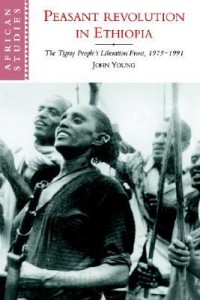|
Reviewed by Dr. Donovan C. Chau, Assistant Professor of Political Science at California State University, San Bernardino As the challenges posed by Africa’s various security problems increase, so to does the need for Westerners to better understand the histories and cultures of Africa’s modern states. This is especially true of those countries on the frontlines of the fight against Islamic terrorism. The paperback reprint of John Young’s Peasant Revolution in Ethiopia (originally published in 1997) is, therefore, a necessary addition to the collections of scholars, analysts, and policymakers alike. Young’s context is the most relevant, contemporary time period in the formation of one of Africa’s most strategically vital nation states, Ethiopia. In fact, in sub-Saharan Africa only Kenya, Nigeria, and South Africa match Ethiopia in geopolitical importance. He centers the book’s attention on the rise and eventual victory of the Tigray People’s Liberation Front (TPLF). In a straightforward manner, Young posits several key research questions; the most salient probe the background of the TPLF demand for self-determination and how the TPLF was able to defeat “the most powerful army in Black Africa.” Young’s focus on the TPLF is significant on other accounts too. The TPLF was one of numerous national liberation movements formed after the military junta known as the Derg overthrew the Haile Selassie regime in 1974. Today, the TPLF forms the central core of the Ethiopian government run by the Ethiopian People’s Revolutionary Democratic Front (EPRDF). Moreover Meles Zenawi, Ethiopia’s prime minister since 1995 and a former TPLF member, is a symbolic and substantive result of the TPLF victory. Young’s specific attention to the Tigray people also sheds insight on the history and culture of Ethiopia. The Tigray, along with other ethnic groups such as the Oromo, have long perceived the central Ethiopian government as forceful ‘foreign’ rulers in the hands of the Amhara. Irreconcilable ethnic challenges, thus, have afflicted Ethiopia throughout its history as Africa’s oldest independent state. And, one also learns the socio-political significance of education and academic standing within the Tigray people; unsurprisingly, teachers and students comprised a crucial portion of the TPLF. Such useful facts on the TPLF and the Tigray are woven throughout the text. Well written, researched, and structured, the book’s three chapters on the course and character of the TPLF revolution are especially useful. The two chapters on Ethiopia’s historical and social landscape as well as the social and political character of the Tigray are also noteworthy. Together, one learns that the central motivating forces behind the TPLF were a sense of Tigray ethnonationalism, pragmatic self-reliant leadership, and the consistently repressive policies of the Soviet-backed Derg. While individual opportunities and leaders mattered (as Young’s first-person interviews attest), the TPLF victory was due in large measure to its comprehension of Mao Tse-tung’s theory of protracted warfare. Young rightly sprinkles this strategic discussion throughout the text. In contrast to its enemies, the TPLF took great care in gaining the support and allegiance of those that mattered most to its struggle, peasants as well as non-Amharic ethnic groups. Strategically and tactically, the TPLF viewed the war as a long-term, full-scale revolution. For example, the TPLF alliance with the Eritrean People’s Liberation Front (EPLF), though intermittent, was of overall strategic value. TPLF recruitment methods and treatment of prisoners of war also demonstrated a nuanced understanding of Maoist theory. Success, as Young points out, was due to TPLF organizational skills (political and military) as well as their level of commitment – both hallmarks of Maoist theory. Less valuable in Peasant Revolution are two chapters on peasant revolution theories and TPLF-peasant relations. Perhaps because the book was a byproduct of Young’s doctoral dissertation these discussions serve at best as bookends to the central discussion. The theoretical importance of Tigray peasants loses substantial weight when Young compares the TPLF to similar revolutionary struggles in Southeast Asia. The TPLF was successful because it took advantage of the strategic significance of peasants in Ethiopia while the Derg did not; one may appreciate this without Young’s theoretical discussions. The context – always supremely relevant in strategy – dictated that the victor would have the side of an essential portion of the population, in this case the TPLF and the peasants. Different contexts would have required differing support bases. Two additions to Peasant Revolution would have been helpful. First, an appendix of significant Tigrinya-to-English terms would have assisted through detailed parts of the text. Similarly, a timeline chronicling the salient events along the rise of the TPLF would have been of assistance as well. These minor criticisms notwithstanding, Young’s expert knowledge of Ethiopia and the complex Horn of Africa region shines through in Peasant Revolution. From his experiences as a journalist and scholar to his governmental and nongovernmental positions, Young demonstrates that it is possible for outsiders – with dedication and hard work – to garner truly commanding knowledge of foreign peoples and lands. Others would do well to follow in his footsteps. |


 Peasant Revolution in Ethiopia: The Tigray People’s Liberation Front, 1975-1991
Peasant Revolution in Ethiopia: The Tigray People’s Liberation Front, 1975-1991